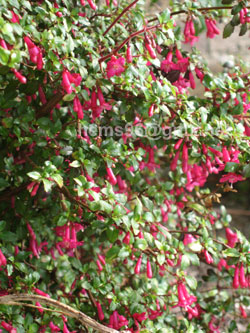Frosthardy Fuchsias which hibernate in milder areas outdoors
Frosthardy Fuchsias are with a few exceptions ot very often found in Central European gardens of Fuchsia friends. The reason for this might be lack of basis info to this thematic and to the right selection of cultivars. Although recently diverse fuchsia societies have investigated some time on this stuff - the info has still not arrived all fuchsia friends.
In Germany some people even believe that the misconceived winter hardness only aplies to coastal areas such as Cornwall (around Scilly Islands), where the golden stream heating takes effect. WEe want to put this into the right light here. In the southern regions of Chile, where Fuchsia megellanicas grow in private gardens and reach 2m in height, or in Sweden, there are no such heat donors like that!
Even if the varieties recommended by the BFS and the NW-Fuchsia Society in this regard are a big help to find these, due to the different climate zones we find in Central europe this info is not always accurate. But such lists give the amateur grower an idea which cvs might prove frosthardy or not and which a worth a trial. Theses list have been done empirically in field tests. The last test has been done by RHS in 2006.
Fuchsias, which are derived from a direct cross with a wildspecies magellanica form are predestinated for this purposes. Also other wild species, which are derived from cooler areas of the Anden mountains come along with good conditions.
Including the following species: F. alpestris, F. bracelinea, F. brevilobis, F. campos-portoi, F. denticulata, F. glazioviana, F. hatschbachii, F. procumbens, F. regia ssp reitzii, F. splendens, F. x thymifolia, F. vulcanica, F. x bacillaris
 >> F. x
bacilliaris in Dublin
>> F. x
bacilliaris in DublinBut also large flowered varieties can be found in such listings (see bew). On the web pages of the NW-Fuchsia Society and the BFS you can find such listings. Here a couple of cultivars, which have been tested in RHS field trials in Surrey/UK and which have been assumed as garden worthy:
Achievement (Z4)
Alice Hoffman (Z3-4)
Alison Patricia (Z3)
Army Nurse (Z4)
Brutus (Z4)
Chillerton Beauty (Z3)
Dark Eyes (Z4)
Display (Z4)
Doctor Foster (Z4)
Dollar Princess (Z4)
Empress of Prussia (Z4)
Flash (Z3-4)
Foxgrove Wood (Z3-4)
Garden News (Z3-4)
Genii (Z4)
Hawkshead (Z4)
Herald (Z4)
Jomam (Z3)
Lady Thumb (Z3)
Lena
(Z3)
Liebreiz (Z3-4)
Madame Cornélissen (Z3)
F. magellanica var. gracilis (Z3)
F. magellanica var. gracilis 'Variegata'
(Z3)
Margaret (Z4)
Margaret Brown (Z4)
Mrs Popple (Z3)
Mrs W P Wood (Z3)
Phyllis (Z4)
Prosperity (Z3)
Riccartonii (Z3)
Rose of Castile Improved (Z4)
Rufus (Z3-4)
Snowcap (Z3-4)
Son of Thumb (Z4)
Tom Thumb (Z3)
White Pixie (Z3-4)
AGM = Award of Garden Merit - a special award which is given to tested cultivars by the RHS
Z4 - frosthardy in GB/Ireland and other milder parts of the countries
Z3 - frosthardy in special situations
You can use that as a basis for further experiments in this field which cvs might prove frosthardy in other areas.
In Surrey, winter temperatures also drop down to -10 ° C. Also in Styria / Austria a trial has been started by a fuchsia friend which gave good results. It should be noted, however, in addition, that the testing area was outside of the winter inversion cold lakes. Whether the received data can be applied to Bavarian or other intra-alpine areas is questionable and remains in any case worthy a try. The question are the plants now hardy in Central Europe - or are they not - hat to be answered with depends on the area you are in.
Concerning the location the location in the garden you plan to
plant frosthardy fuchsias - they tolerate more direct sun
and should be planted slightly deeper and should have enough time to
establish well. This prevents root ball
from beeing moved by freezing to the surface of soil and may allow new
plant shoots from root zone in the following spring.
A mulch layer of dry material to the root area as well as a
light reflecting fiber material can help your fuchsias to hibernate
well outdoors.
More info soon available!
Home:
Wild species (incl. sektions)
Bilddatenbank
